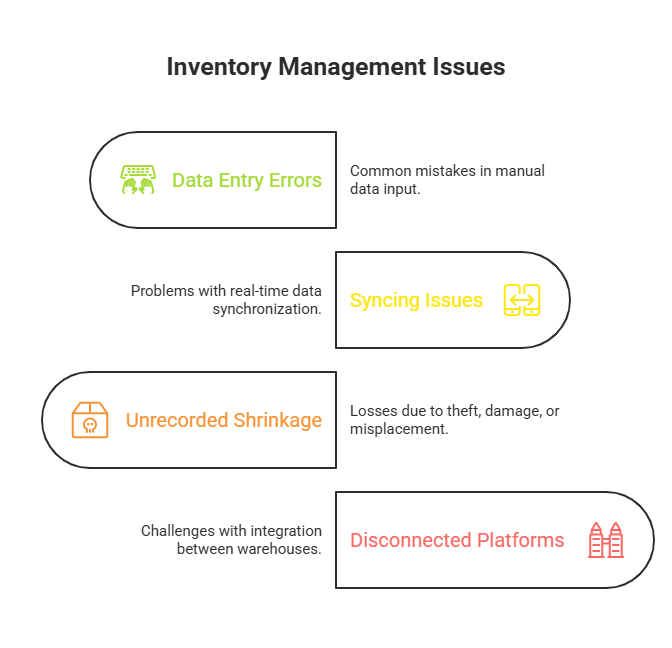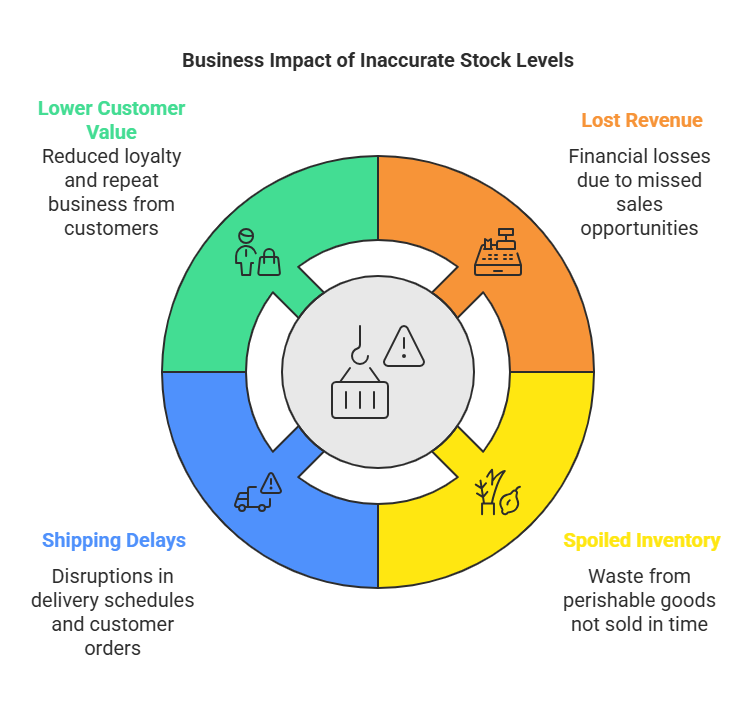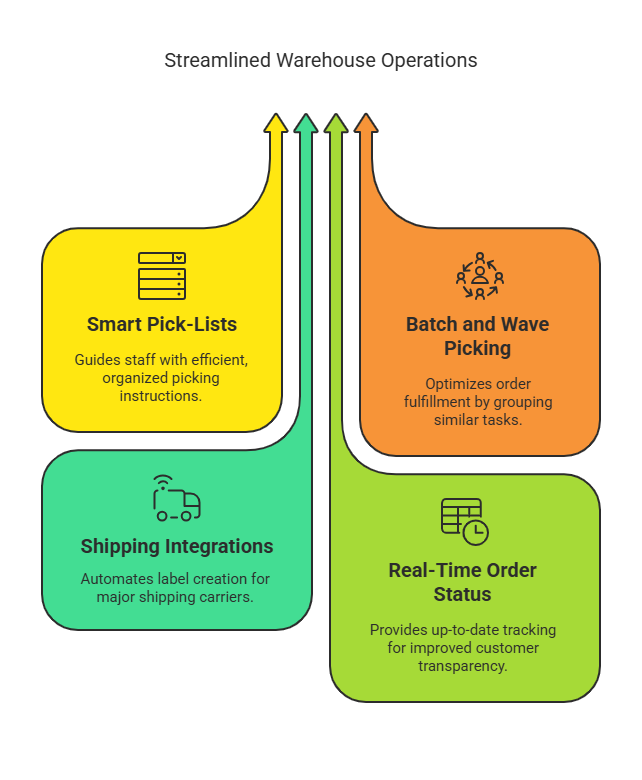5 Common Inventory Management Challenges and How Leading Software Solutions Address Them

Introduction
Inventory management isn’t just about tracking what’s in your warehouse. It’s about balance—having the right product, in the right place, at the right time, and in the right quantity. For many businesses, especially those scaling quickly or handling multiple sales channels, inventory becomes one of the most complex—and critical—areas to get right.
According to IHL Group, inventory distortion—caused by stockouts and overstocking—costs global retailers over $1.8 trillion annually. That’s not just a logistics problem—it’s a business problem.
In this blog, we’ll explore five common inventory management challenges that businesses of all sizes face, and break down how leading software solutions—including Fishbowl, Zoho Inventory, GOIS, and others—help solve them through technology, automation, and smart planning.
Challenge 1: Inaccurate Stock Levels
Imagine this: your e-commerce store just sold a high-demand product. The customer is thrilled. But when your warehouse team goes to pick the item—it’s not there. Your system said you had three in stock, but your shelves say otherwise.
This kind of stock inaccuracy is more than an inconvenience. It’s a revenue leak.
Why It Happens
Most inaccuracies stem from:
- Manual data entry errors
- Lack of real-time syncing
- Unrecorded shrinkage (theft, damage, misplacement)
- Disconnected warehouses or platforms

According to Wasp Barcode Technologies, 43% of small businesses still rely on manual tracking or no inventory system at all. That leaves room for massive discrepancies.
The Impact
- Customers receive late or canceled orders
- Teams waste hours resolving stock disputes
- Overstocking or understocking decisions are based on flawed data
- Margins suffer due to emergency orders or write-offs
The Fix: Real-Time Inventory Visibility
Modern inventory software automates and validates every transaction, eliminating guesswork. With barcode scanning, every item that enters or leaves your warehouse is recorded in real-time. RFID and mobile scanning reduce human error dramatically.
- 🟨 Zoho Inventory offers barcode and batch tracking along with cycle count support.
- 🟦 Fishbowl Inventory shines for QuickBooks users needing tight inventory integration and serialized tracking.
- 🟩 GOIS supports multi-location real-time tracking with robust mobile apps for small to mid-sized businesses.
Challenge 2: Overstocking and Stockouts
Too much stock ties up cash. Too little loses sales. Striking the right balance is an art—and a science.
Understanding the Imbalance
- Overstocking often comes from fear—fear of missing a sale. But it leads to high holding costs and wastage, especially with perishables.
- Stockouts usually result from poor forecasting or delayed reordering—and they can drive loyal customers to competitors.
According to McKinsey & Company, 71% of customers will switch brands if their desired product is unavailable.
The Business Fallout
- Lost revenue
- Spoiled or discounted inventory
- Shipping delays due to last-minute restocking
- Lower customer lifetime value

The Fix: Demand Forecasting & Reordering Automation
Inventory software with AI-powered forecasting uses historical sales, seasonality, and supplier lead times to project demand accurately. Pair this with automated reorder points and you’ve got a system that orders just enough—just in time.
- 🟨 Zoho Inventory helps businesses set reorder levels and automate PO creation.
- 🟦 NetSuite offers enterprise-grade demand planning with predictive analytics.
- 🟩 GOIS provides easy-to-use replenishment thresholds and sales analytics for trend-based purchasing.
Challenge 3: Inefficient Order Fulfillment
A smooth purchase experience doesn’t end at checkout—it ends when the right product reaches the customer, fast. That’s where many businesses falter.
Where It Breaks Down
- Unorganized warehouse layouts
- Manual picking and packing processes
- Sales orders not synced with fulfillment
- No integration with shipping carriers
Shopify Plus notes that 45% of shoppers expect orders to arrive in 2 days or less.
The Business Impact
- Shipping delays → refunds or bad reviews
- Wrong items shipped → costly returns
- Labor-intensive fulfillment → rising costs
The Fix: Streamlined Warehouse Operations
With inventory software, businesses gain:
- Smart pick-lists that guide warehouse staff
- Batch and wave picking to fulfill multiple orders efficiently
- Shipping integrations that auto-generate labels for UPS, FedEx, DHL
- Real-time order status for tracking and transparency
- Fishbowl offers warehouse optimization tools and advanced picking strategies.
- Zoho Inventory automates shipping label generation and real-time tracking updates.
- GOIS gives even small teams access to centralized order dashboards and shipping sync.
Challenge 4: Lack of Integration Between Systems
Your sales team uses Shopify, your accounts team uses QuickBooks, and your warehouse team uses spreadsheets. Sound familiar? This kind of fragmented system setup leads to data silos—and chaos.
Why Integration Matters
Disjointed tools create:
- Conflicting stock levels across platforms
- Manual duplication of entries
- Slower decisions due to missing or outdated data
- Errors in fulfillment, purchasing, and reporting
As Forbes notes, these silos don’t just slow you down—they make your data untrustworthy.
The Fix: Seamless System Syncing
Today’s inventory systems come with plug-and-play integrations for:
- E-commerce platforms (Shopify, WooCommerce, Amazon)
- Accounting software (QuickBooks, Xero, Zoho Books)
- CRMs and ERP systems
- Shipping carriers and 3PLs

- 🟦 Fishbowl is built to work tightly with QuickBooks, Salesforce, and UPS/FedEx.
- 🟨 Zoho Inventory connects across the Zoho ecosystem and external platforms.
- 🟩 GOIS supports Shopify, WooCommerce, QuickBooks, and ERP integrations via API.
With unified systems, businesses get a 360-degree view of operations, reducing errors and boosting agility.
Challenge 5: Scalability Issues
What works when you’re handling 100 orders a month might break when you hit 1,000. Many businesses outgrow their inventory processes—without realizing it.
Where Scale Fails
- Systems lag under high transaction volumes
- Multi-warehouse support becomes clunky or nonexistent
- New SKUs, bundles, or channels overwhelm your tracking
- Manual work multiplies, requiring more staff (and more errors)
As per TechRadar’s Inventory Software Review, scalability is often the #1 reason businesses switch systems.
The Fix: Cloud-Based, Modular Software
Scalable inventory platforms offer:
- Cloud infrastructure with no performance caps
- User access controls for growing teams
- Multi-location inventory support
- Modular features that evolve as you grow
- Zoho Inventory grows with small to mid-sized teams, offering advanced features without high costs.
- NetSuite scales from mid-market to enterprise, supporting multi-country, multi-currency operations.
- GOIS is ideal for SMEs that need advanced features (like warehouse transfers and order batching) without enterprise pricing.
Conclusion
Inventory management is no longer just a backroom function. It’s a revenue enabler, a customer satisfaction driver, and a scalability backbone.
From inaccurate stock levels to fulfillment delays, the challenges we’ve discussed are universal. But so are the solutions—if you choose the right tools.
Fishbowl is great for manufacturers and QuickBooks users. Zoho Inventory offers a robust, affordable solution for multi-channel sellers. GOIS bridges the gap for fast-growing SMBs that want real-time control without an ERP-sized budget.
While each inventory software has its strengths, GOIS stands out as a particularly strong choice for growing small to mid-sized businesses that need flexibility without complexity. It’s designed for teams that are often on the move—offering real-time inventory visibility, intuitive mobile apps, and multi-location management that doesn’t require IT-heavy setup. Unlike some platforms that are either too basic or too enterprise-focused, GOIS strikes the right balance: powerful enough to handle omnichannel operations, yet simple enough for lean teams to implement and scale. For businesses prioritizing ease of use, mobile functionality, and quick deployment, GOIS makes a compelling case as a go-to inventory solution.
| Feature / Scenario | GOIS | Zoho Inventory | Fishbowl Inventory |
| Multi-location management | ✅ Built-in multi-location tracking with real-time sync across warehouses & stores | ✅ Supported, but advanced controls require Zoho One ecosystem | ✅ Supported, but ideal for centralized operations |
| Mobile Accessibility & Field Usage | ✅ Dedicated mobile app for inventory, orders, and stock movements on the go | ⚠️ Mobile-friendly, but not fully featured for warehouse users | ⚠️ Limited mobile functions; desktop-centric |
| Ease of Setup for SMBs | ✅ Quick onboarding, no-code setup, and minimal IT involvement | ⚠️ Requires familiarity with Zoho Suite for best results | ❌ Requires server setup or IT support for full functionality |
| Omnichannel Support | ✅ Integrates directly with Shopify, WooCommerce, and POS systems | ✅ Integrates well with major marketplaces | ⚠️ Marketplace support available, but requires add-ons or third-party tools |
| Pricing Flexibility | ✅ Transparent pricing with tiered plans suitable for startups to mid-sized companies | ✅ Affordable plans for small teams | ❌ Higher upfront cost and recurring licensing f |
What’s most important is not which tool you pick—but that you move beyond manual, disconnected processes. The longer you wait, the more it costs.
Frequently Asked Questions (FAQs)
1. What is the biggest challenge in inventory management?
Inaccurate stock tracking. When inventory levels aren’t updated in real time, it causes stockouts, overselling, and financial losses.
2. What software is best for small businesses?
Zoho Inventory and GOIS are ideal for small businesses due to their ease of use, scalability, and affordability.
3. Can inventory systems integrate with my existing tools?
Yes. Most leading solutions integrate with platforms like QuickBooks, Shopify, WooCommerce, Amazon, FedEx, and more.
4. How does inventory software improve order fulfillment?
By automating pick-lists, routing orders to the right location, and syncing with shipping carriers for faster dispatch.
5. How do I know when it’s time to upgrade my inventory system?
If you’re frequently running out of stock, overstocking, manually updating spreadsheets, or growing your sales channels—it’s time.